
Efficient Rules for a Unicausal Accident Strict liability is the straightforward Pigouvian answer Negligence,as interpreted by economists,gives the right answer too You are liable if you failed to take all cost justified precautions If you are liable,it is in your interest to....So either you do or you do That assumes the court knows What precautions you took And what precautions you should have taken So it is a partly regulatory solution Strict liability only requires you to know-leverages your private information Activity level is shorthand for unobservable precautions
Efficient Rules for a Unicausal Accident • Strict liability is the straightforward Pigouvian answer • Negligence, as interpreted by economists, gives the right answer too • You are liable if you failed to take all cost justified precautions • If you are liable, it is in your interest to … .So either you do or you do • That assumes the court knows • What precautions you took • And what precautions you should have taken • So it is a partly regulatory solution • Strict liability only requires you to know—leverages your private information • Activity level is shorthand for unobservable precautions
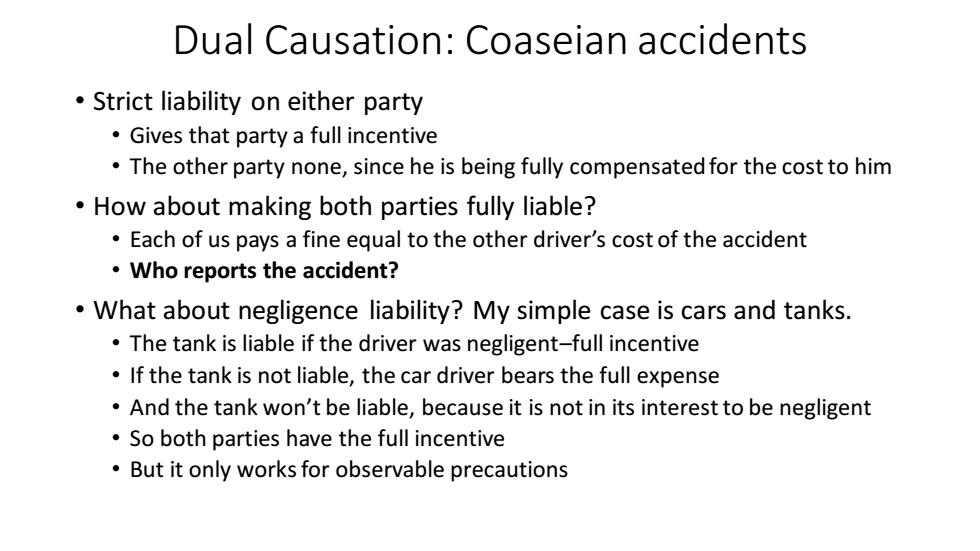
Dual Causation:Coaseian accidents Strict liability on either party Gives that party a full incentive The other party none,since he is being fully compensated for the cost to him How about making both parties fully liable? Each of us pays a fine equal to the other driver's cost of the accident Who reports the accident? What about negligence liability?My simple case is cars and tanks. The tank is liable if the driver was negligent-full incentive If the tank is not liable,the car driver bears the full expense And the tank won't be liable,because it is not in its interest to be negligent So both parties have the full incentive But it only works for observable precautions
Dual Causation: Coaseian accidents • Strict liability on either party • Gives that party a full incentive • The other party none, since he is being fully compensated for the cost to him • How about making both parties fully liable? • Each of us pays a fine equal to the other driver’s cost of the accident • Who reports the accident? • What about negligence liability? My simple case is cars and tanks. • The tank is liable if the driver was negligent–full incentive • If the tank is not liable, the car driver bears the full expense • And the tank won’t be liable, because it is not in its interest to be negligent • So both parties have the full incentive • But it only works for observable precautions
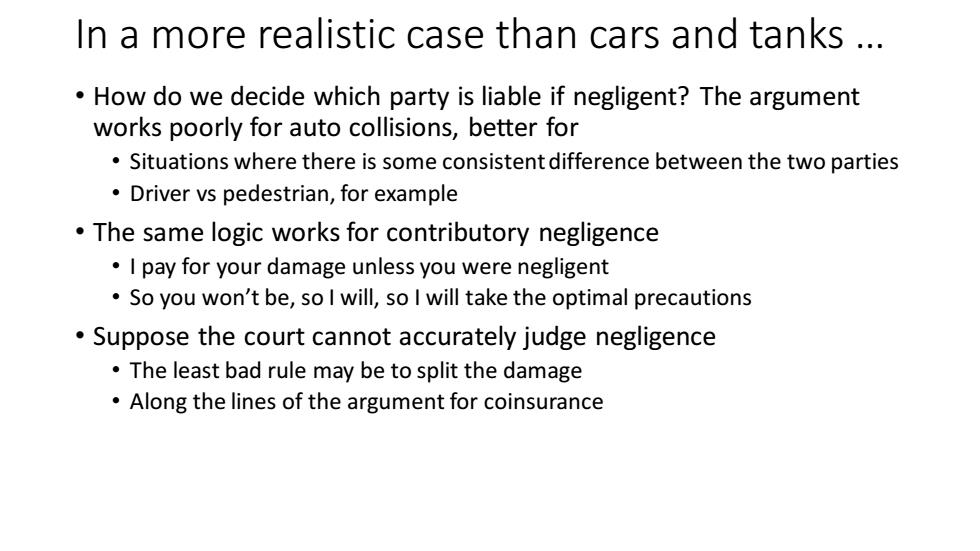
In a more realistic case than cars and tanks .. How do we decide which party is liable if negligent?The argument works poorly for auto collisions,better for Situations where there is some consistent difference between the two parties Driver vs pedestrian,for example The same logic works for contributory negligence I pay for your damage unless you were negligent So you won't be,so I will,so I will take the optimal precautions Suppose the court cannot accurately judge negligence The least bad rule may be to split the damage Along the lines of the argument for coinsurance
In a more realistic case than cars and tanks … • How do we decide which party is liable if negligent? The argument works poorly for auto collisions, better for • Situations where there is some consistent difference between the two parties • Driver vs pedestrian, for example • The same logic works for contributory negligence • I pay for your damage unless you were negligent • So you won’t be, so I will, so I will take the optimal precautions • Suppose the court cannot accurately judge negligence • The least bad rule may be to split the damage • Along the lines of the argument for coinsurance
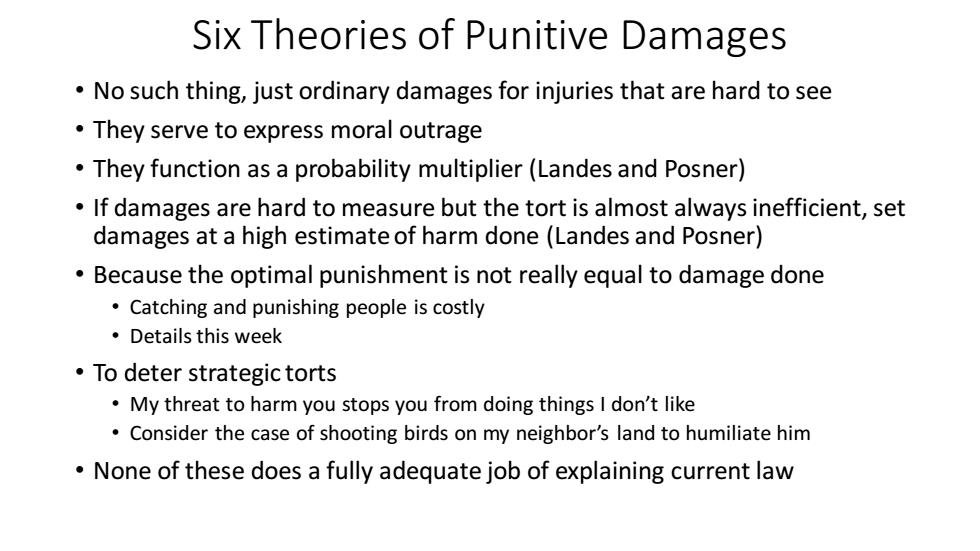
Six Theories of Punitive Damages No such thing,just ordinary damages for injuries that are hard to see They serve to express moral outrage They function as a probability multiplier (Landes and Posner) If damages are hard to measure but the tort is almost always inefficient,set damages at a high estimate of harm done (Landes and Posner) Because the optimal punishment is not really equal to damage done Catching and punishing people is costly ·Details this week To deter strategic torts My threat to harm you stops you from doing things I don't like Consider the case of shooting birds on my neighbor's land to humiliate him None of these does a fully adequate job of explaining current law
Six Theories of Punitive Damages • No such thing, just ordinary damages for injuries that are hard to see • They serve to express moral outrage • They function as a probability multiplier (Landes and Posner) • If damages are hard to measure but the tort is almost always inefficient, set damages at a high estimate of harm done (Landes and Posner) • Because the optimal punishment is not really equal to damage done • Catching and punishing people is costly • Details this week • To deter strategic torts • My threat to harm you stops you from doing things I don’t like • Consider the case of shooting birds on my neighbor’s land to humiliate him • None of these does a fully adequate job of explaining current law
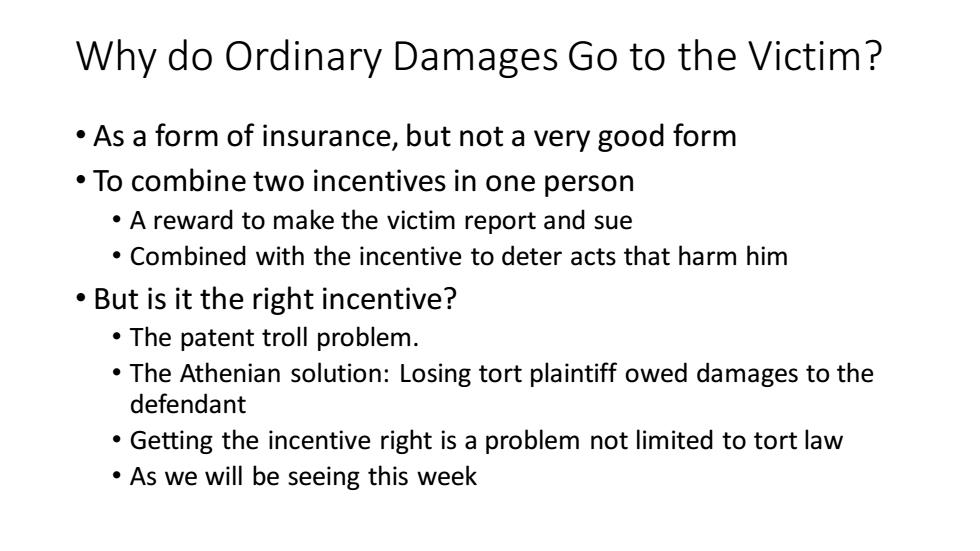
Why do Ordinary Damages Go to the Victim? As a form of insurance,but not a very good form To combine two incentives in one person A reward to make the victim report and sue Combined with the incentive to deter acts that harm him But is it the right incentive? The patent troll problem. The Athenian solution:Losing tort plaintiff owed damages to the defendant Getting the incentive right is a problem not limited to tort law As we will be seeing this week
Why do Ordinary Damages Go to the Victim? • As a form of insurance, but not a very good form • To combine two incentives in one person • A reward to make the victim report and sue • Combined with the incentive to deter acts that harm him • But is it the right incentive? • The patent troll problem. • The Athenian solution: Losing tort plaintiff owed damages to the defendant • Getting the incentive right is a problem not limited to tort law • As we will be seeing this week

Damages Are Doing Triple Duty The damage payment for a tort is The penalty to the tortfeasor The reward to the successful plaintiff The compensation to the victim There is no reason to expect the right value to be the same for each
Damages Are Doing Triple Duty • The damage payment for a tort is • The penalty to the tortfeasor • The reward to the successful plaintiff • The compensation to the victim • There is no reason to expect the right value to be the same for each
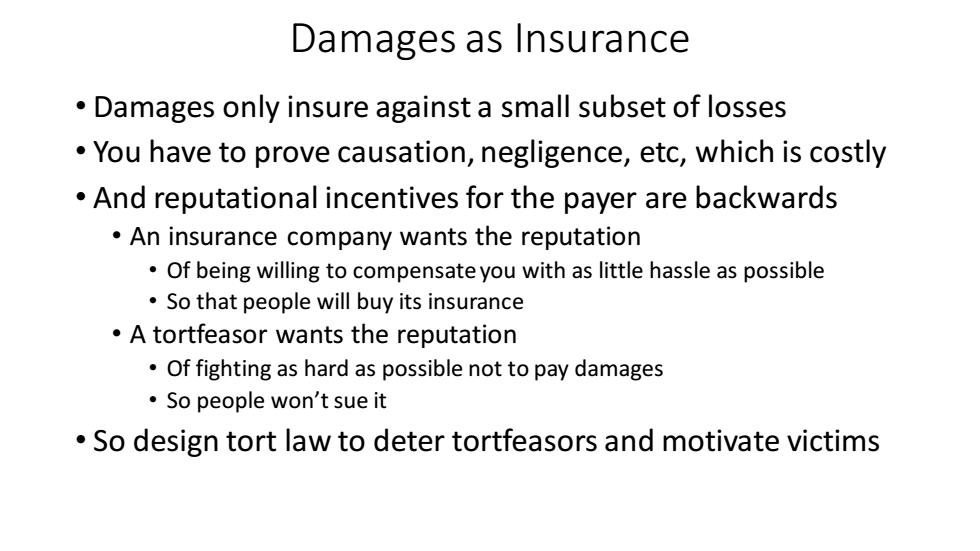
Damages as Insurance Damages only insure against a small subset of losses You have to prove causation,negligence,etc,which is costly And reputational incentives for the payer are backwards An insurance company wants the reputation Of being willing to compensate you with as little hassle as possible So that people will buy its insurance A tortfeasor wants the reputation Of fighting as hard as possible not to pay damages ·So people won't sue it So design tort law to deter tortfeasors and motivate victims
Damages as Insurance • Damages only insure against a small subset of losses • You have to prove causation, negligence, etc, which is costly • And reputational incentives for the payer are backwards • An insurance company wants the reputation • Of being willing to compensate you with as little hassle as possible • So that people will buy its insurance • A tortfeasor wants the reputation • Of fighting as hard as possible not to pay damages • So people won’t sue it • So design tort law to deter tortfeasors and motivate victims
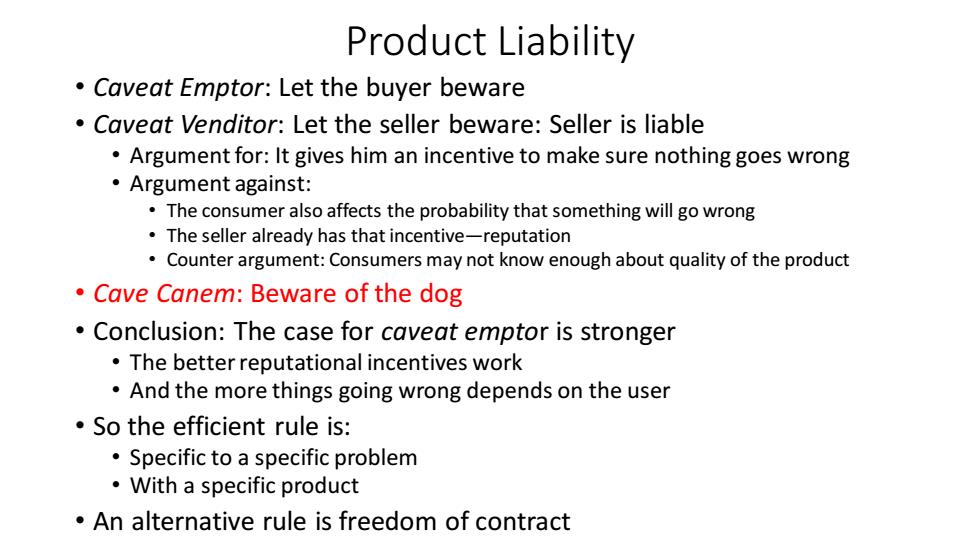
Product Liability Caveat Emptor:Let the buyer beware Caveat Venditor:Let the seller beware:Seller is liable Argument for:It gives him an incentive to make sure nothing goes wrong 。Argument against: The consumer also affects the probability that something will go wrong The seller already has that incentive-reputation Counter argument:Consumers may not know enough about quality of the product Cave Canem:Beware of the dog Conclusion:The case for caveat emptor is stronger The better reputational incentives work And the more things going wrong depends on the user So the efficient rule is: Specific to a specific problem With a specific product An alternative rule is freedom of contract
Product Liability • Caveat Emptor: Let the buyer beware • Caveat Venditor: Let the seller beware: Seller is liable • Argument for: It gives him an incentive to make sure nothing goes wrong • Argument against: • The consumer also affects the probability that something will go wrong • The seller already has that incentive—reputation • Counter argument: Consumers may not know enough about quality of the product • Cave Canem: Beware of the dog • Conclusion: The case for caveat emptor is stronger • The better reputational incentives work • And the more things going wrong depends on the user • So the efficient rule is: • Specific to a specific problem • With a specific product • An alternative rule is freedom of contract
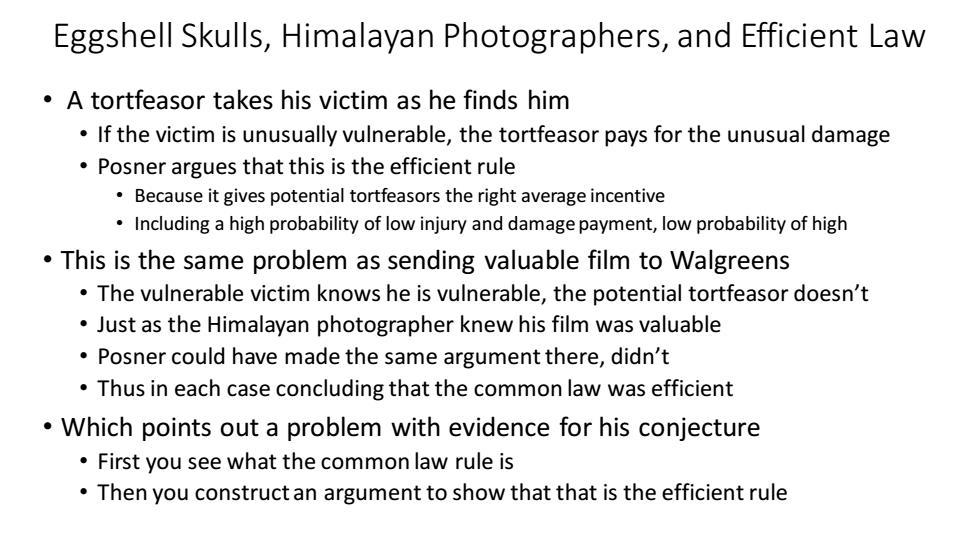
Eggshell Skulls,Himalayan Photographers,and Efficient Law A tortfeasor takes his victim as he finds him If the victim is unusually vulnerable,the tortfeasor pays for the unusual damage Posner argues that this is the efficient rule Because it gives potential tortfeasors the right average incentive Including a high probability of low injury and damage payment,low probability of high This is the same problem as sending valuable film to Walgreens The vulnerable victim knows he is vulnerable,the potential tortfeasor doesn't Just as the Himalayan photographer knew his film was valuable Posner could have made the same argument there,didn't Thus in each case concluding that the common law was efficient Which points out a problem with evidence for his conjecture First you see what the common law rule is Then you construct an argument to show that that is the efficient rule
Eggshell Skulls, Himalayan Photographers, and Efficient Law • A tortfeasor takes his victim as he finds him • If the victim is unusually vulnerable, the tortfeasor pays for the unusual damage • Posner argues that this is the efficient rule • Because it gives potential tortfeasors the right average incentive • Including a high probability of low injury and damage payment, low probability of high • This is the same problem as sending valuable film to Walgreens • The vulnerable victim knows he is vulnerable, the potential tortfeasor doesn’t • Just as the Himalayan photographer knew his film was valuable • Posner could have made the same argument there, didn’t • Thus in each case concluding that the common law was efficient • Which points out a problem with evidence for his conjecture • First you see what the common law rule is • Then you construct an argument to show that that is the efficient rule
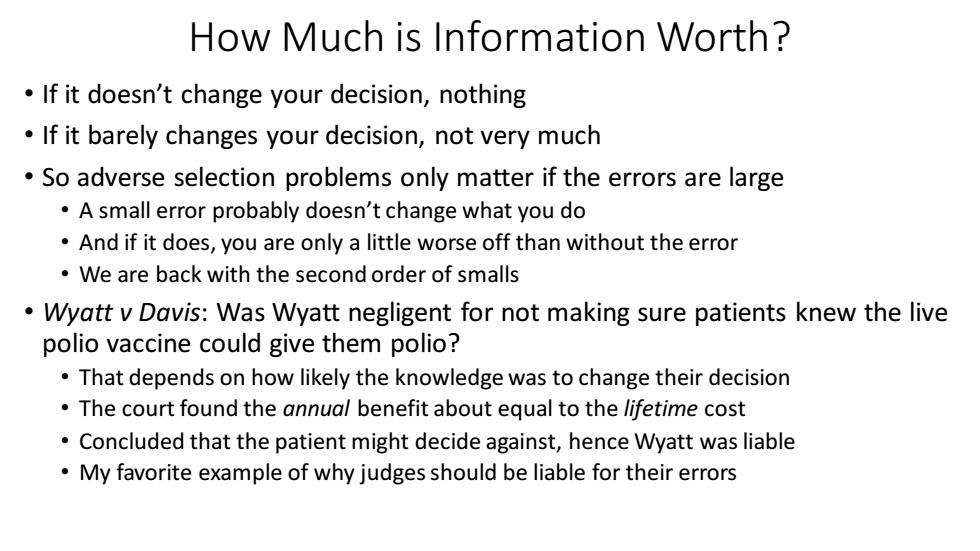
How Much is Information Worth? If it doesn't change your decision,nothing If it barely changes your decision,not very much So adverse selection problems only matter if the errors are large A small error probably doesn't change what you do And if it does,you are only a little worse off than without the error We are back with the second order of smalls Wyatt v Davis:Was Wyatt negligent for not making sure patients knew the live polio vaccine could give them polio? That depends on how likely the knowledge was to change their decision The court found the annual benefit about equal to the lifetime cost Concluded that the patient might decide against,hence Wyatt was liable My favorite example of why judges should be liable for their errors
How Much is Information Worth? • If it doesn’t change your decision, nothing • If it barely changes your decision, not very much • So adverse selection problems only matter if the errors are large • A small error probably doesn’t change what you do • And if it does, you are only a little worse off than without the error • We are back with the second order of smalls • Wyatt v Davis: Was Wyatt negligent for not making sure patients knew the live polio vaccine could give them polio? • That depends on how likely the knowledge was to change their decision • The court found the annual benefit about equal to the lifetime cost • Concluded that the patient might decide against, hence Wyatt was liable • My favorite example of why judges should be liable for their errors